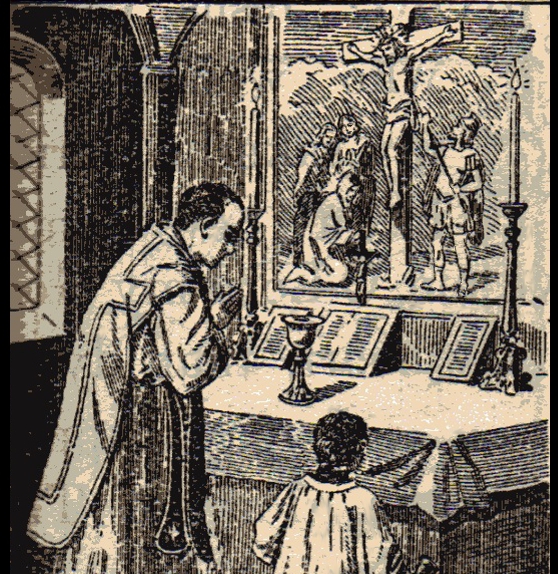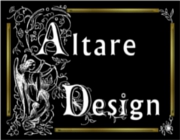 The Ars Orandi blog has posted a couple of essays assessing the “Dialogue” Mass, and I have to say that if Rorate Caeli chooses to sign off as “neutral” on the subject, I in contrast wish to go on record as agreeing with David’s conclusions. I am not an advocate of the Dialogue Mass. I say this, not with disparagement of “dialogue” advocates, but because some of us have tried, have seen, have experienced different methods, and my personal conclusion has been that the most gratifying, most soul-stirring, most prayerful way of assisting at Mass begins by freeing oneself from the constraints of having to vocalize in unison as in the N.O., so as to have liberation of one’s mind and heart. In this way, it is so much easier to pray the Mass in a unitive and meditative way. I hope that my posting of THEOLOGY OF THE TRIDENTINE MASS in pictures will be one aid for those who desire a more intimate way of praying the Mass.
The Ars Orandi blog has posted a couple of essays assessing the “Dialogue” Mass, and I have to say that if Rorate Caeli chooses to sign off as “neutral” on the subject, I in contrast wish to go on record as agreeing with David’s conclusions. I am not an advocate of the Dialogue Mass. I say this, not with disparagement of “dialogue” advocates, but because some of us have tried, have seen, have experienced different methods, and my personal conclusion has been that the most gratifying, most soul-stirring, most prayerful way of assisting at Mass begins by freeing oneself from the constraints of having to vocalize in unison as in the N.O., so as to have liberation of one’s mind and heart. In this way, it is so much easier to pray the Mass in a unitive and meditative way. I hope that my posting of THEOLOGY OF THE TRIDENTINE MASS in pictures will be one aid for those who desire a more intimate way of praying the Mass.
As David writes, really, the dialogue Mass is a poor way of assisting at the Sacrifice: “…When one achieves a deeper appreciation of what “active participation” entails, it becomes clear that, quite to the contrary, other methods of hearing Mass are more beneficial for those striving to unite themselves more intimately with the mysteries represented in the Mass. “…it [dialoguing] is a poor method of hearing Mass,…”
Here are some other highlights of his essay:
“the Dialogue Mass is a novelty of the 20th century rather than a product of any previous generation…and “it was practiced as an innovation, among so many others, by the movers of the 20th Century Liturgical Movement.”
“The Dialogue Mass does not appear in any official Church documents until 1958 with the instruction, De musica sacra et sacra liturgia,…”
“It should be noted for historical clarity, that the same person who was responsible for crafting much of what became the novus ordo, was also responsible for De musica sacra et sacra liturgia [instructions for the Dialogue Mass], Archbishop Annible Bugnini.”
[Quote from Eamon Duffy’s The Striping of the Altars]: “This tradition, embodied in such works as the Meditationes Vitæ Christi, stressed the spiritual value of vivid mental imagining of the events of the life of Christ, especially his Passion, to ‘make hym-selfe present in his thoghte as if he sawe fully with his bodily eghe all the thyngys that be-fell abowte the crosse and the glorious passion of our Lorde Ihesu.’ This search for spiritual communion with God through vivid picturing of the events of Christ’s life and death was, of course, evolved as part of an individual and intensely inner spirituality. But it came to be applied to the liturgy itself, and to be seen as the ideal way of participating in the Church’s worship.”
The intent of the essay is summarized thus:
“It is equally imperative that the laity educate themselves and their neighbors about traditional liturgical piety that renders the most fitting worship possible, and renders the greatest benefits, such as unitive prayer and contemplation.”
To which I might add, “…just like our Blessed Mother at the foot of the cross.”




Encyclicals are wordy documents containing infallible doctrine, but they themselves are not infallible in practical propositions or applications, as for example, “ We also exhort you, Venerable Brethren, to promote with care congregational singing, and to see to its accurate execution with all due dignity.” That’s a tall order!
We know that singing – like drawing – is an art. Not everyone can sing, just as not everyone can draw a horse. This analogy comes to mind because I use to mentor a young girl, and I tried to teach her to draw. She told me she could not draw. I told her she could if she would just repeat the movements I made,while keeping in mind simple geometric shapes. We tried to draw a horse. After frustrating attempts, we both concluded that she couldn’t draw.
This past summer, I attended the CMAA colloquium. All those present were there because they WANTED to sing. It turns out that desire is not sufficient. One of the ladies dropped out of the polyphony choir because for the life of her, she just couldn’t hit the notes. Such lovely people, full of zeal, with great desires to love and serve the Lord will not be able to accurately execute “with all due dignity” what MD proposes for the faithful, even with Master teachers as is the case at the colloquium.
I used to sing in a choir. It takes a lot of work and many practice sessions.
And even if one can sing beautifully, why not just join the schola, or choir? “Soloists” in the congregation are a distraction, a distraction against which sometimes one has to fight in order to be able to contemplate what is happening at the re-presentation of our Lord’s Passion.
You pique my feminine curiosity. Yes, we are in Kankakee. Is your family able to help us in this apostolate? If so, I would like to make contact. Otherwise, I will mortify my curiosity. 🙂
God bless you and yours!
I would be careful to separate what is truly of the N.O. (theological deficiencies) versus legitimate aspirations – which simply conform with what Popes St. Pius X (motu proprio), Benedict XV, Pius XI, and Pius XII (Mediator Dei), plus a host of orthodox liturgists desired to occur.
You are correct that one does not have to respond, but the Church has made it clear that not only is active participation (a phrase coined by Pope St. Pius X – not Modernists) through posture, singing or responding is a laudable and praiseworthy thing, but also the ideal – Pius XII is clear on this in Mediator Dei.
By the way, I presume that you are in Kankakee? So are two sides of my family, so of who still reside there from what I have seen on the Internet. (e-mail me privately if you wish)
Yes, now you know that I am not a young chick.
From my experience, it is mainly the new arrivals from the N.O. who feel it to be a duty to dialogue at the TLM. And it is mainly the N.O. clergy who believe it a necessity in order to “actively” participate. I am here to say, “No, one does not have to utter a peep in order to wholly immerse oneself in the Mass, to participate, and to derive immense benefit!”
At a one of the TLM’s sponsored by this Latin Mass Community, I found out the pastor had come incognito to observe. He voiced his disapproval, not with the attendance which was larger than what he got at most of his Masses; not with the sermon; not with the piety and devotion of the faithful; not with the musical accompaniment – which was absolutely beautiful; not with the modest dress and reverence of those attending; not with the collection to which the congregation contributed generously….but with the people who he said “just sat there”. Imagine! The crime of traditionalists, it seems, is to want to pray the Mass silently!
The common mentality of the N.O. crowd is that for a Mass to be a “proper” Mass, there must be visible and audible commotion. It ain’t so! I am sick and tired of a N.O. mentality which I fear will spill over into our TLM’s.
Canon Hesse… boy, that goes way back!
I never had the chance to meet him, but I did listen to his American recordings many years ago. While he could often make some very good distinctions, I am oblige to also say that occasionally he could exaggerate certain things as well.
The main point I would impress though, is that making the responses *with the server* was historically *the* practice in the Roman Church. But certainly, the server should be leading the faithful.
Thank you for commenting, Mr. Tofari. Far be it from me to say I have done a thorough research. But I once did ask Canon Hesse, and he did reply that it was proper for the responses to be made by the altar boy, not the congregation. That, and my own experience tell me that the dialogue Mass is not for me. I honestly do find it distracting and even annoying. I will continue to follow the debate with interest.
“The Dialogue Mass does not appear in any official Church documents until 1958 with the instruction, De musica sacra et sacra liturgia,…”
I am the author of the 2 articles that Rorate Caeli cites against Mr. Wierling’s, and I wanted to make two clarifications:
1. The above quote is incorrect – the first “official Church document” about the Dialogue Mass occurred in 1922 via the Sacred Congregation of Rites which ruled that it could be adopted by the local bishops if they deemed it expedient. The practice was also promoted in 1947 via Pius XII’s great liturgical encyclical, Mediator Dei. More importantly, it was used on at least two occasions at St. Peter’s Basilica by traditional popes themselves (as cited in my first article).
2. The Dialogue Mass is not a “20th century modernist novelty” – it existed before the Protestant Reformation as ample historical facts (letters) attest, and diminished in use simultaneously and in conjunction with the loss of Gregorian chant. They were likewise (and logically) restored together as well.
Hope this helps to clarify this important matter.